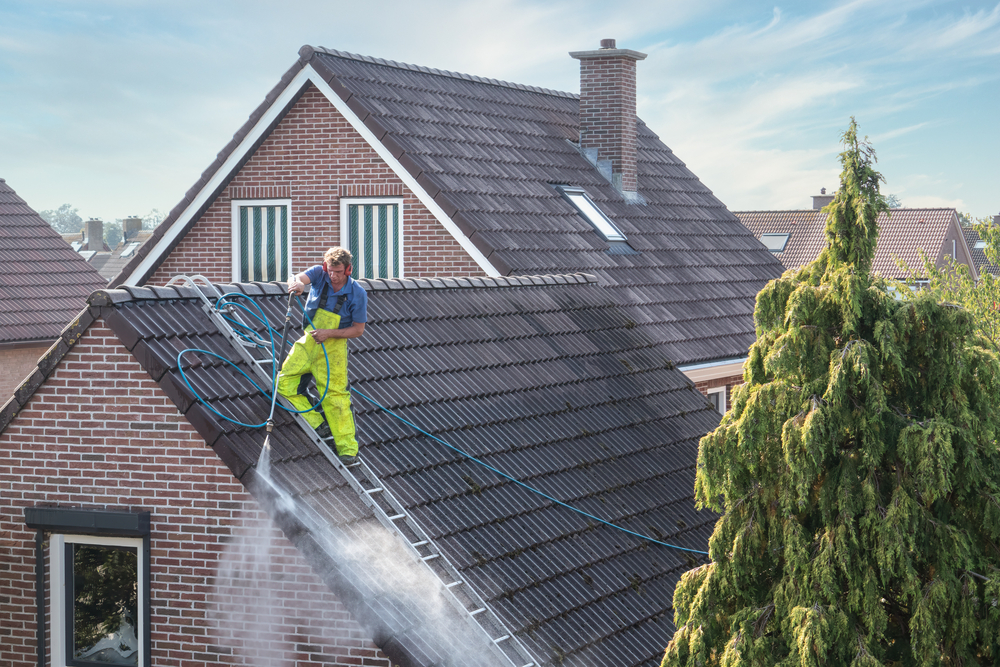

We may earn revenue from the products available on this page and participate in affiliate programs. Learn More ›
- Typical Range: $100 to $650
- National Average: $296
Houses look so fresh and clean when their siding is new, windows are bright, and walkways are scrubbed. Over time, Mother Nature’s power takes its toll, pouring down rain filled with chemicals; blowing dirt, seeds, leaves, and pollen against the surface of siding; trapping bits and pieces in gutters and seams; and making the once-fresh siding look dingy and tired. At one time, the only way to clean siding was with a bucket, brush, and tons of elbow grease, but luckily, technology has provided houses with a better option: pressurized water focused into a stream or fan to remove the debris from almost any hard surface. Pressure washers are so powerful that they can clean far better than friction or chemical cleansers.
It may seem odd to pay the national average cost to pressure wash a house—$296—to pressure wash house siding. After all, most homes have a spigot and a garden hose, so why is the expense necessary? First, the only real similarity between a garden hose and a pressure washer is that water flows through a tube in both tools. Garden hoses are dependent on the local water pressure and a nozzle to increase the force with which the water leaves the hose. Pressure washers use a gasoline or electric engine to fire a compressor. As water enters the hose on the washer, the compressor forces the water into a thin metal tube or wand and then further compresses it as it blasts through a small nozzle at the end. This compression causes the water to travel at 100 to 200 times the pressure of the air, or between 1,500 and 3,000 pounds per square inch. A pressure washer will clean the siding, roof, patio, deck, fence—pretty much anything it’s pointed toward—but it needs to be handled with great care because it’s a powerful and potentially dangerous tool. Ideally, homeowners should consider hiring a pressure washing service to handle the task. To determine the cost, homeowners can search for a pressure washing estimate calculator online or call a number of companies that do house pressure washing. But first, it’s important to understand what makes up the cost of hiring a pressure washing pro.
Pressure Washing vs. Power Washing
These two terms are often used interchangeably, and the processes are similar, but when scheduling a cleaning it’s important to note the difference. Both pressure washing and power washing use compressed jets of water to blast surfaces clean. Pressure washing uses cold water, relying on the force of the stream (along with any cleaner or degreasing agents that are mixed in) to remove grease, dirt, pollen, and stains. Power washing uses hot water or hot steam and can include the same cleansers as pressure washing, depending on the application. There’s a clear benefit to warmer water: It will dissolve greasy stains and gently heat the surface, making it easier for debris to slide off. There is a cost difference between pressure and power washing, though, because heating the water requires an additional component in the power washer, and more protective equipment is required. How much to power wash a house? The cost is higher than pressure washing at about $0.15 to $0.75 per square foot.
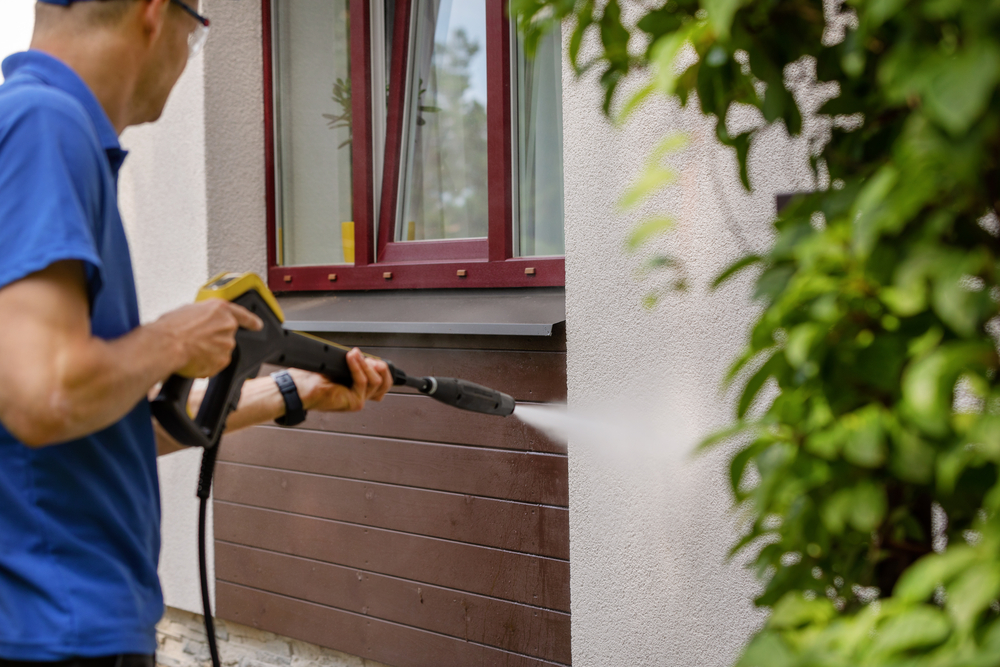
Factors in Calculating the Cost to Pressure Wash a House
How much should it cost to pressure wash a house? The total cost is dependent on a number of factors, including basics such as the size of the project and the amount of time it will take, along with the materials to be washed and the complexity of the whole job. In order to request useful estimates, homeowners will need to consider the following aspects of their pressure washing job. Many contractors include a minimum charge to make sure the job covers the materials, travel, and labor—in other words, they’ll need to make sure the job is worth their time.
House Size
Most often, the cost basis for pressure washing a home begins with size. The size of the home affects everything about the cost of the job—the amount of labor, the volume of cleansing solution, the time it will take to complete—so many jobs are priced based on the square footage of the house. Generally the cost is approximately $0.10 to $0.50 per square foot. Rather than parceling the cost out foot by foot, many contractors have a pre-established base price for homes based on their approximate size, style, and number of stories.
House Materials
Not all types of house cladding hold up well to the strong force of pressurized water. Great care must be taken when pressure washing wood siding because it’s soft and can easily crack or splinter under the force. Aluminum siding can easily lose its finish or dent under the pressure. As a result, the cost of pressure washing wood or aluminum siding is a bit higher because it takes more time and care to do safely. Vinyl siding can be pressure washed more quickly and is therefore less expensive; however, it must still be done properly, because like wood, vinyl siding can be damaged by the pressure. If the house is covered with fiber cement siding, pressure washing isn’t recommended and may even invalidate the warranty. Roofs, decks, and patios will be a little more expensive than siding because it’s so easy to damage or etch them with the sprayer, while driveways cost less to wash because the material is so solid that the pressure of the water is less likely to cause damage.
Project Complexity
Simple jobs such as pressure washing a 1-story home that’s moderately dirty won’t be particularly taxing for technicians, so the cost will be toward the lower end of the range. Every layer of complexity adds to the time and the cost of the project, so complicated roof lines, landscaping, or grading that makes ladder placement challenging, or a mix of materials that requires repeated adjustment of the pressure and cleanser, will add to the cost. Adding other elements to the project, however, can make the project more cost-effective. If you’re planning to have the house washed, then add the driveway, gutters, and patio, the overall cost will be higher than washing the house alone, but the total may be far less than if you had each of those elements washed separately. It’s worth asking the contractor if they’ll reduce the costs if you bundle several projects together.
Project Time Frame
Another factor in how much it costs to pressure wash a house is the project duration. In general, the longer it takes to pressure wash the house, the higher the expense. This is simply because a longer project takes more manpower and therefore increases the overall labor costs of the project.
Seasonality
In general, it’s preferable and less costly to pressure wash a house during the warmer months of the year. The colder months bring the complication of potential freezing to some areas, which hugely complicates the process of washing and can be disastrous from a safety standpoint, so very cold weather can equal a higher cost. From the homeowner’s standpoint, it’s not cost-effective to wash a house just before the winter comes; the combination of moisture, weaker sunlight, and longer nights can mean that mold or mildew will take hold before the yard is reopened the following spring, and the house will need to be washed again.
Labor
Labor costs will vary based on the local market where the house is located, ranging from $25 to $100 per hour. In addition, while some companies create their charges based on a flat rate for the type or size of home, others tack on labor as a separate charge, which means that projects that take longer because of the home’s condition or complexity will cost more in labor as well as materials.
Geographic Location
The average cost for pressure washing a home varies from state to state. In general, coastal states in the northeastern United States and California have some of the highest costs, including surprisingly high average costs of $472 in Rhode Island, $344 in New York, and $362 in Maryland, as well as an average of $369 in California. Hawaii and Alaska also ring up high costs at $463 and $371, respectively. When comparing these rates to lower averages in other areas, such as $255 in Arkansas, $245 in Georgia, and $286 in Oregon, residents of more expensive areas may be frustrated, but this disparity in cost likely has to do with the cost of water supply, the style and size of the home, the damage caused by colder winter weather or salt spray, and local taxes and ordinances.
Additional Costs and Considerations
Beyond these basic elements of cost calculation, there are other components that factor into the total cost of pressure washing a home. Each part of a home requires particular preparation and technique to clean effectively without risking damage to the structure. Water is surprisingly powerful when pressurized and can easily slice through more delicate materials, so pressure washing services may charge different fees based on what’s being cleaned.
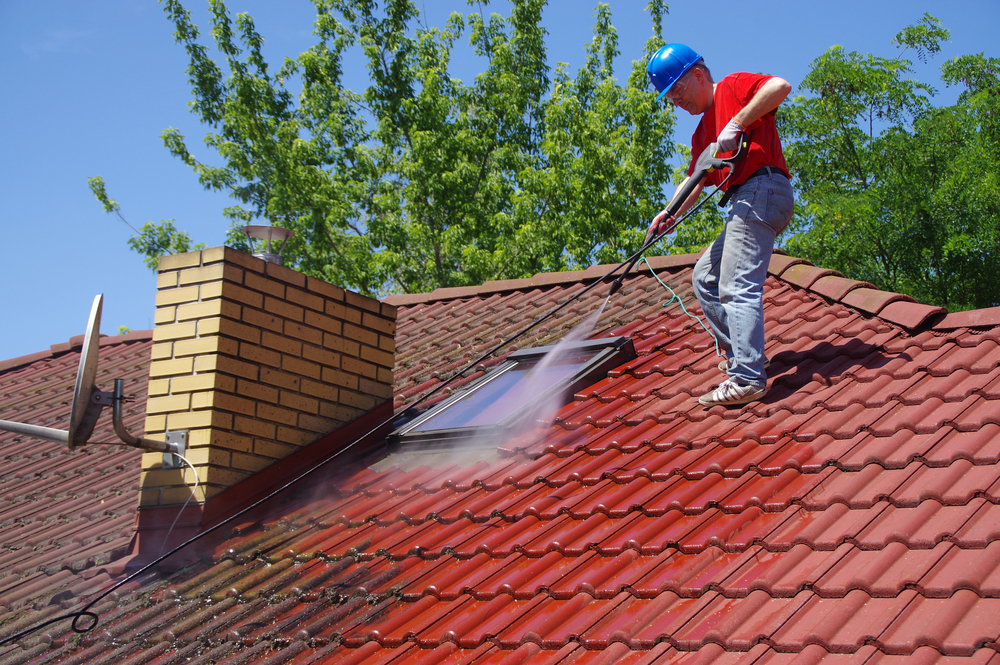
Preparation
Is there a lot of landscaping around the home? The immediate perimeter of the building will be flooded with water as the house is cleaned, and that water may have diluted cleaner in it. Tender plantings will need to be covered, wetted down, and potentially pulled aside to allow ladder access to upper stories. If furniture needs to be moved off a patio or deck, that will cost extra in labor charges, or it may be an added line-item cost. Some of this cost can be abated by the homeowner. It’s worth asking the contractor what needs to be done ahead of time and whether or not it’s something the homeowner can do before the workers arrive at the home to save time and money.
Pressure Washing Siding
The cost of pressure washing siding will vary based on the material. Delicate materials such as wood, stucco, or aluminum siding must be washed at a lower pressure, which can take longer to remove built-up dirt and grease, and therefore will incur more labor cost. Vinyl siding and stone or brick material can be washed on a higher pressure setting and will therefore cost less.
Pressure Washing Windows and Doors
Windows and doors are particularly vulnerable areas when pressure washing a structure. Why? Because water likes to find its way inside even when it’s not pressurized. Add force behind it, and it can make its way through insulation, weatherstripping, and good, solid seals—ruining the seal, potentially the door or window, and the walls and floors beneath it. Great care must be taken to use a lower-pressure nozzle in a wider fan pattern to avoid direct hits on the margins of the windows and doors, and to avoid a direct shot of water on the center of the glass so as not to shatter it. This level of caution results in more time and effort and will add to the cost of the job.
Pressure Washing Gutters
Pressure washing gutters adds approximately $50 to $300 to the pressure washing bill, averaging out to about $0.50 to $1.50 per linear foot. This requires the use of an extension wand and a specific nozzle to target trouble spots inside the gutter. If the house is too tall for the extension wand, a technician may need to climb up onto the roof to clean the gutters manually, adding significantly to the safety risk and equipment needs, and therefore the cost. Should the gutters develop ice dams during colder weather, a power washer can use heated water to blast away ice for about twice the cost of a regular wash.
Pressure Washing Roof
Cleaning a roof with a pressure washer requires skill, finesse, and most of all, risk. The technician has to haul tubing, wands, and nozzles and brushes up to the roof, balance carefully as the force of the pressurized water pushes them back, and negotiate on an angled, wet surface. Roof cleaning costs between $0.50 and $1 per square foot.
Additional Pressure Washing Services
Once you see the almost magical cleaning that a pressure washer can conjure, chances are you’ll start looking around to see what else could be cleaned with this method. Patios, decks, driveways, fences, lawn furniture, and children’s play structures can benefit from the forceful flow of water. Flat surfaces such as walkways and garage floors can be cleaned with a surface cleaner attachment that seems to melt away grime. It’s worth considering what else could be added to the job once the decision has been made to hire pressure washing services for the house—many companies will bundle the various surfaces to be cleaned and offer a discounted price, which will likely be much less expensive than hiring them to come back a second time.
Do I Need to Pressure Wash My House?
If pressure washing your house seems like an unnecessary expense, you may want to reconsider. Cleaning a home’s exterior isn’t just a cosmetic exercise: Over time, a buildup of dirt, pollen, grease, and minerals can weaken the siding, invite pests to burrow in, and reduce the lifespan of the home’s exterior. Pressure washing can be part of a maintenance schedule yearly or every other year (residents of areas where homes aren’t subjected to much debris may be able to do a simple wash with a garden hose on alternating years), but there are some signs that it’s time for a home to have a bath.

Regular Maintenance
Face it: A dirty home has less curb appeal than a clean one. Sometimes homeowners can get caught up in the idea that “in 4 years, we’ll have saved enough to replace the siding, so there’s no need to keep it up for now,” or think that because their siding is old it can’t be cleaned well so there’s no point. Pressure washing can render most types of siding clean, shining, and nearly new-looking, even if it’s old. Putting off maintenance in the hope of replacing siding can lead to a home that looks tired, invites criticism from the neighbors, and invites pests. As with any other surface in the house, the exterior needs regular scheduled maintenance to perform at its best.
Dirty or Discolored Siding
Siding collects debris. Whether it’s the faux wood grain in vinyl siding; the actual wood grain on shingle or wood clapboard; the seams on aluminum; or the textured face of brick, stucco, or stone, there are tons of crevices and snags for pollen, dirt, bark chips, seeds, pollen, and animal droppings to lodge in. Over time, this debris builds up and can cause staining or discoloration of the exterior. If the debris stays in place long enough, it can even cause uneven fading of the siding. Regular cleaning will keep the home’s exterior looking fresh and new and will actually prolong the life of the siding.
Visible Mold or Mildew
Sometimes it seems like mold and mildew can develop overnight. One day, the shady back of the house is clean and fresh, and just a couple of rainy days later it’s coated with a hazy green film of algae and mold, or the blackish gray staining of mildew. Every home has a side or face that doesn’t get any sun, so mold and mildew are likely something you’ll have to deal with at some point or another. Home improvement stores advertise bleach washes to kill the mold and mildew at the source, but undiluted harsh chemicals can damage the home’s finish and kill nearby plant life. Pressure washing blows the mold and mildew out of the texture of the siding, and if the contractor adds bleach solution to the wash mixture, it can safely reduce the likelihood of immediate regrowth. Solutions that promise to prevent growth do so by leaving a film of chemical on the siding, which isn’t healthy for the finish. Regular washing is a more sustainable option.
Clogged Gutters
Can gutters be cleaned manually? Sure. But pressure washing them removes water stains, blasts out clogs in the downspouts, and removes buildup in the seams and joints that collect other debris that can lead to clogs. Clogged gutters are no joke—they can lead to leaks and failures and cause leakage inside the house; they can also invite birds and pests to nest in the clogs.
Pest Infestations
Insects need food to survive and will be more than happy to find it in the siding on a house. Wood siding that holds years’ worth of tree and plant debris offers a haven for insects to nest, and once they’ve discovered a food source, they’ll be inclined to burrow deeper. Grimy foundations can conceal evidence of rodent intrusion until it’s much too late. Pressure washing the house regularly will keep the buildup to a minimum and make it easier to see if any areas on the perimeter of the home need attention.
Increased Energy Bills
Allowing dirt to build up on the outside of a home can reduce the efficiency of the siding’s inherent insulation. Worse, it can clog, coat, or cover critical ventilation that allows the home to breathe and vent the byproducts of heating and cooling systems. If the energy bill has been edging up, consider whether cleaning the exterior and vent system would let the house do its job better.
Benefits of Pressure Washing a House
Watch an online video of a pressure washer in use. The number of views these videos receive shows just how mesmerizing many people find it to watch something that they maybe didn’t even recognize as filthy suddenly be stripped clean. Pressure washing can remove dirt that wasn’t necessarily obvious and improve the look of the house without making any actual changes.
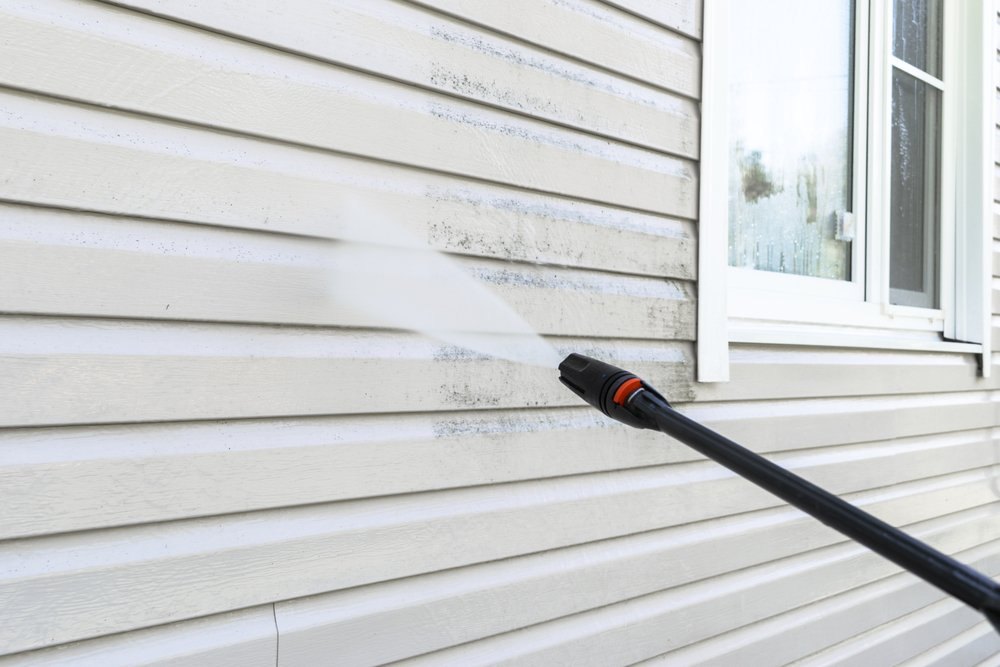
Improved Curb Appeal
The house will look better from the street when the trim is pristine, the siding gleams, and the driveway and walkway are clean and welcoming. Even old siding can be freshened up with a good pressure wash, and compared with the cost of new siding, the cost of pressure washing is a bargain.
Increased Home Value
Buyers who see dingy siding and stained walkways see a home that hasn’t been kept up. This may lead them to wonder what else hasn’t been kept up and to scrutinize the home inspector’s report more carefully. First impressions are important to the value the buyer sees, so it’s reasonable to take a step to make that first impression one of a home that is ready to move into. All the fresh paint and careful staging work inside won’t matter if the outside doesn’t appeal. In addition, pressure washing the home will reduce the likelihood of pests, again adding to a clean bill of health from the inspector.
Damage Prevention
Keeping the exterior cladding clean maintains its structural stability longer. Dirt and pollen are abrasive and have chemicals in them that can slowly break down the protective coatings on the siding; the longer the debris remains on the siding, the more likely it is to wear away the color, pattern, and design of the exterior.
Healthier Living Environment
Anyone with allergies knows the sensation on that first day in the spring when all the flowers and trees suddenly burst into leaf and flower. The pollen is so thick that it coats cars and other surfaces, including homes, with its trademark yellowish green. Most people don’t think twice about taking the car to the car wash to clear out the pollen, and a house deserves that same treatment. Otherwise, the pollen will stick, collect more pollen, and then gradually get sucked into air intakes in the HVAC system, tracked into the house months after the rest of the pollen has cleared, and continue to rain gently down on guests seated on the patio. Similarly, insect infestations and birds nesting in the clogged gutters can cause structural damage or bring disease into the house. Washing the exterior of the house makes the home cleaner and safer.
DIY vs. Hiring a Professional
The best pressure washers can be purchased at most home improvement stores and are available with gas or electric power. The pressure washers sold in home improvement stores are aimed at homeowners, as they’re not quite as forceful as professional models. For a homeowner who is experienced with this type of tool, capable of the maintenance of the machinery (which is not insignificant; it’s an engine that is in constant contact with water), and aware of the safety considerations that are involved with using pressurized water, this could be an option. Pressure washers save a lot of water over using a regular garden hose and get the house much cleaner, which is a plus. Many pressure washers aimed at this market aren’t designed to last long, especially under heavy use, so it’s a significant up-front expense that may not pay out over the years.
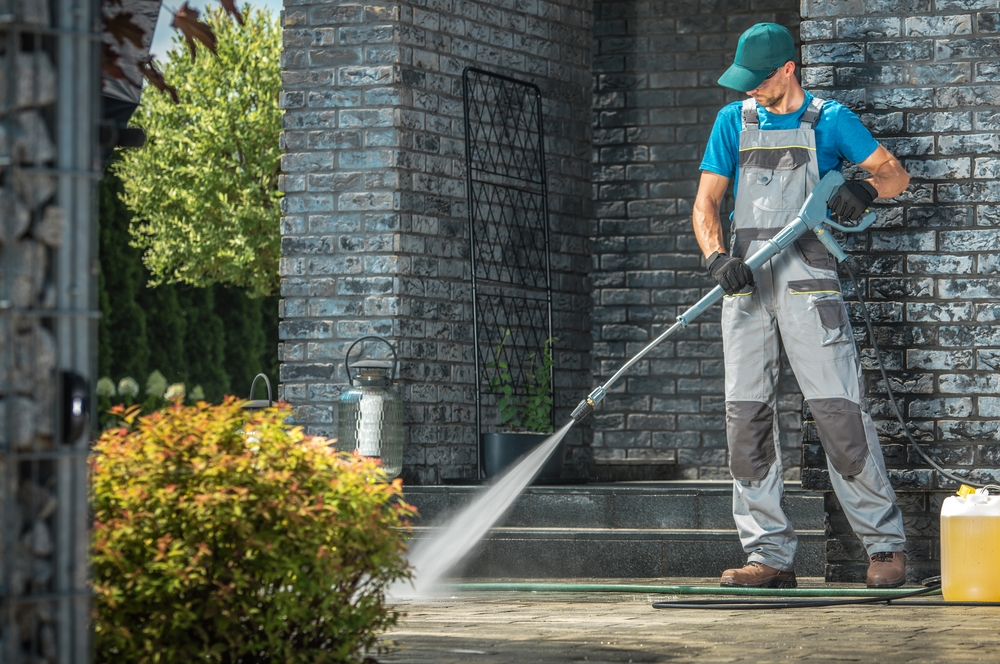
However, there are very real reasons to leave this particular task to a professional. Many people don’t realize just how dangerous water can be. Pressurized water is used in many industries to cut metal parts and slice stone; what kind of a chance will toes clad in fabric shoes have if the wand errantly swings down? Or a finger that slips through the stream? Pressure washers can cause catastrophic lacerations when they cut through clothing and skin, even at low pressure. Certainly many power tools wielded by casual users can cause injury, but most people are aware of the dangers posed by holding a chainsaw on a ladder, while most people don’t necessarily think that the force of water blasting out of a pressure washer’s wand could blow them backward off that same ladder. To prevent injury, a homeowner needs eye protection, a face shield, solid shoes, feet on the ground—and some luck.
If the danger to the user isn’t enough, there’s also a huge potential for damage to the surfaces being washed and their surrounds. Using a pressure washer on softer surfaces requires knowing the correct pressure, the correct nozzle, and the correct angle to avoid irreversibly damaging the surface. Using the washer incorrectly can blast concrete off a foundation or patio in slices, raise the hairs in the wood on a finished deck, and force water underneath the siding or shingles and drive it inside. When washing an older home, a sharp fan of water may dislodge lead paint, flinging it into the air and poisoning the soil around the perimeter of the house. Nearby trees and plantings can be sliced or crushed by the force of the water.
Buying a pressure washer may seem like a way to save money, but unless you have the experience, safety equipment, and know-how to use it properly, it’s worth it to let a professional handle the task.
How to Save Money on Pressure Washing Your House
Especially if it’s an every-other-year expense, pressure washing a house isn’t the most expensive maintenance item on the list, but there are certainly ways to save on costs.
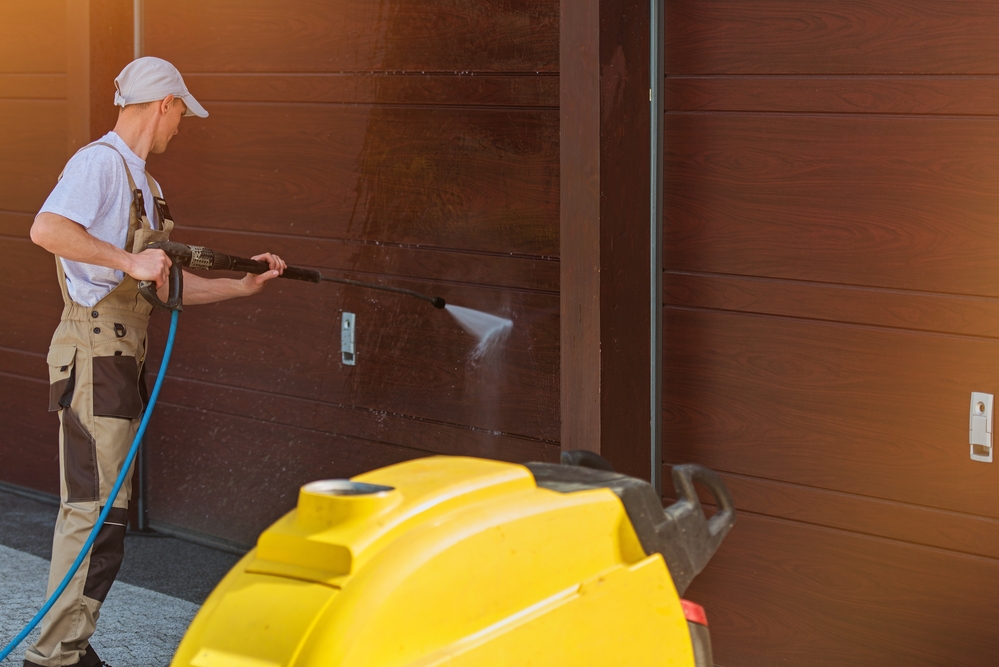
- Check around the house and yard, and ask the contractor if they’ll bundle several pressure-washing projects into a reduced-price package.
- Talk to the neighbors: Often companies will offer a reduced rate if several houses on the same street schedule services on the same day or days.
- Ask if the company offers a reduction in price if you allow them to post an advertising sign in your yard for a period of time.
- Find out if you can do some of the preparation—moving furniture, covering plants, protecting delicate areas—instead of paying the contractors for the extra labor time.
Questions to Ask a Contractor About Pressure Washing Your House
As with any contractor, you’ll want to ask questions about the methods and materials they’ll use, the experience of their workers, and their licensing and insurance, but the dangers inherent in pressure washing (especially on a multistory home) mean some of those questions take on extra importance.
- May I see proof of insurance coverage? Are your workers completely covered should they be injured during the job?
- How are your technicians certified? What kind of training and experience do they need to have to be hired?
- What kind of quality control do you do on the work after it’s finished?
- What is your cleaning process? How do you handle windows and vent openings?
- What is your process if the siding/windows/landscaping is damaged during the cleaning?
- What recourse do I have if I’m dissatisfied with repairs?
- Do you have references I can contact?
- What do I need to do before you arrive? Should screens be left in or removed? Furniture? Attached awnings or pergolas?
FAQs
Because there are so many varieties of surfaces and conditions for pressure washing, it can be difficult to get a handle on what you actually need to ask. The following are some of the most common questions, along with their answers, to help get you started as you research the best options for you.
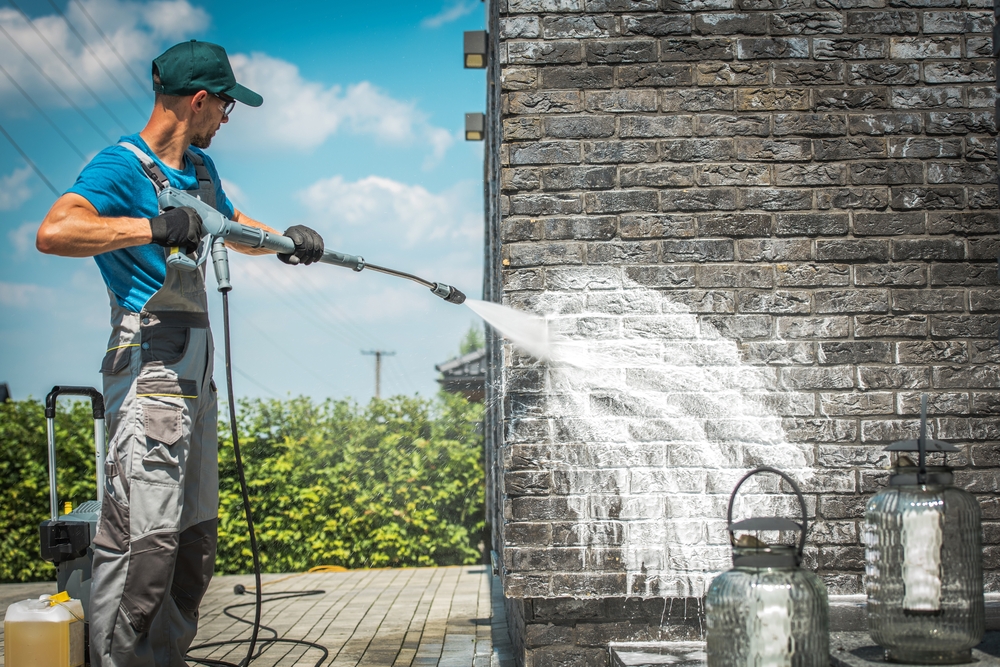
Pressure washing is always worth it. Power washing, which is pressure washing with heated water, may or may not be, depending on the material on the outside of your home. On one hand, hot water makes the process faster and more effective, melts away grease and dirt, and is less likely to require chemical cleaning agents. However, many siding materials can’t handle the heat—vinyl siding may even melt or warp.
You can, and you should! However, vinyl siding requires a bit of TLC. It’s soft, so you shouldn’t use heated water, and you should begin with a low pressure and gradually increase it. It’s better to make several passes on a lower setting than one pass on a higher setting, which could crack or bend the siding. It’s also important to make sure the spray is hitting the siding straight on or angled slightly downward; angling the spray up can force water underneath the siding, causing damage to the siding and the underlayment.
It can. When used on a very light pressure setting by an experienced technician, pressure washing painted surfaces can be safe. If there’s any possibility that there’s lead paint on the surface or beneath it, however, pressure washing is a bad idea, as the paint may be chipped off or spread.
Generally, you should plan to pressure wash or power wash a house once a year or every other year in the warmer months, usually between March and November. The weather is favorable and the sun is strong enough to dry the house before new debris can settle in the water droplets and adhere.
If you mean can you pressure wash your house, then the answer will depend on the material on the outside of your home, the age of the material, and the condition. If it’s in poor condition or is very old, the blast of water from a pressurized wand might just chip off the surface and leave you with a bigger problem than a dirty house. If it’s in good condition, then you can!
Most professionals suggest once a year, but that can depend on your location, how many trees surround the home, the weather, and the surface material. In some cases, every other year makes more sense so that the siding isn’t subjected to such heavy pressure every year, and a quick rinse with a strong hose can suffice in between.
Pressure washing refers to using a stream of pressurized water to blast away dirt and grime from a surface. Power washing is a type of pressure washing that uses superheated water or steam to accomplish this task instead of cold water. Sometimes the terms are used interchangeably, but the only real difference is heat.
Sources: HomeAdvisor, Angi, HomeGuide, Fixr
